Nothing secret about potato salad in my family
Plus why so many Germanic recipes include potatoes
Release Date: February 28, 2025
Sometimes it makes me sad my family doesn’t have a “secret” recipe – you know, the one that is passed from one hand to the next across generations, and bequeathed in wills.
Instead, we just have recipes.
Good recipes. But more likely to have been ripped from the pages of Southern Living or Lady’s Home Journal than from the hands of a half-frozen ancestor crossing the Wetterstein Mountains barefoot in a blizzard, and wearing only a fur muff.
That said, as a Germanic family, we do have a good many recipes based on potatoes, and the humble potato has deep roots in my ancestorial homeland, so maybe there is a secret — or at least a good story —in there somewhere.
Please hit the ❤️ button at the bottom of the page to help this story reach more readers. And if you’re not already a subscriber, I’d love to have you join me. Thanks!
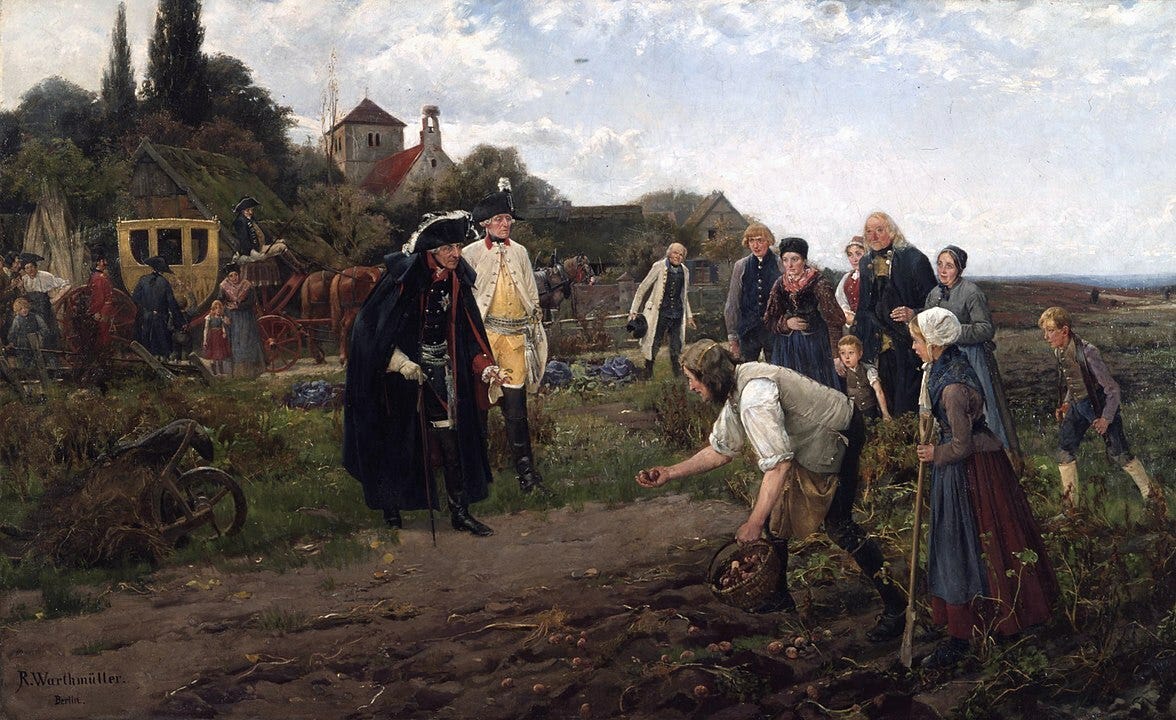
King Frederick the Great and the Devil’s Apple
If you want to know why potatoes play such a big role in German food, look no further than Frederick the Great, the King of Prussia from 1740 to 1786, a span of four decades.
The story goes that early in his reign, Frederick came to understand the importance of finding a food source for locals that wasn’t grain. Grain, of course, was needed to feed Frederick’s army, and if the peasants were eating too much grain, then his Prussian soldiers wouldn’t have enough to defeat whatever enemy they might face.
And Frederick knew there’d be a lot of enemies.
So, in 1756, he issued one of what turned out to be many Kartoffelbefehls, official potato orders:
“You are to make the benefit of planting this crop clear to the lords and subjects, and advise them to undertake the planting of potatoes this early year as a very nutritious food…Wherever there is an empty space, the potato should be cultivated, since this fruit is not only very useful to use, but also so productive that the effort put into it is very well rewarded.”
People across what would, in 1871 become a unified Germany, began planting potatoes.
And, with so many potatoes planted, they started creating recipes — everything from potato dumplings and potato au gratin to potato salad.
The rest, as they say, is culinary history. At least in my family!
BTW potatoes were called “the devil’s apple” back then due to a slight aka deadly misunderstanding. Like all members of the nightshade family, the tops of potato plants can be poisonous if eaten, while the bottoms, as we know, can be both tasty and safely consumed. In the early days, however, folks sometimes got that backwards and served the tops to guests, resulting in, let’s just say, less than favorable results and bad reviews.
Grandma’s secret ingredient
Born in 1908, my grandma, Elvira Stelljes, was a product of both family history and current events, especially when it came to cooking, baking and kitchening.
Grandma grew up in a small immigrant community in Minnesota, surrounded by a large extended family and others with roots deep in German, Bohemian, Polish and Austrian soil. Her father, Henry Stelljes, was a cigar maker, and he and Maggie Gareis, her mom, ran a small boarding house and restaurant which welcomed travelers and steamboat passengers with a clean bed and warm food.
Family stories have been passed down that Maggie was a stickler when it came to food for her guests – only the finest ingredients, the tastiest recipes, the most beautiful presentations.
It was, I’ve been told, a sharp contrast to the way Grandma and her six brothers ate around the family table. “Guest food”, as it was called, was strictly verboten. Memories of that injustice stuck with Grandma for the rest of her life, and became the bedrock of her unwavering commitment to everyday hospitality.
I remember mid-week, no-occasion meals of wild rice pilaf, homemade chicken Kiev, and freshly baked rhubarb crisp ala mode served on bone-china plates and eaten with monogramed cutlery. That Grandpa, Howard Semerau, had just come off the river from a morning of fishing, or that I was too young to know where Kiev was didn’t matter a hoot. Family got the good stuff too where Grandma was concerned.
So, there was that, but Grandma was also deeply influenced, permanently impacted, by the history which took place outside her home.
She was a little girl when the Great War broke out, a young woman when the stock market crashed, and a wife and mother when WWII brought ration cards and Victory Gardens to towns big and small.
My grandma was a product of, if not exactly want, most definitely mandated scarcity.
She knew how to make do with whatever she had on hand, to preserve pickles and jams and jellies, and bake from scratch anything that could fit in an oven. Her chest freezer was always full and the floor-to-ceiling shelves in her basement were continually stocked and restocked with canned goods. I remembering being tasked with shelving an entire case of black olives as a teenager, and asking why we needed so many when nobody in the family liked them.
Because we can, said Grandma.
Even after my grandparents settled into a long and abundant retirement, Grandma carried with her a no-waste mentality. Nothing got thrown away. The bone from Easter ham went into split pea soup, and stale bread and pieces of the knust were turned into breadcrumbs, and stuffing. I remember Grandma using old cans to bake delicious Boston Brown Bread, and the cuttings from vegetables to make broth.
But my most vivid memories of Grandma’s no-waste philosophy revolve around old Cool Whip® containers.
Her small galley kitchen had been designed in the early 1900s and, although updated with a modern stove, oven, electric refrigerator and kitchen sink, had retained its original size. It was efficient, but storage space was definitely at a premium.
Yet, the largest space in the kitchen, the corner cabinet on the bottom, was filled with Cool Whip® containers. Stacks and stacks of them.
My grandma considered old Cool Whip® containers the no-cost answer to every storage question.
Leftovers? Grab a Cool Whip® container.
Made too much biscuit dry mix? Grab a Cool Whip® container.
Scraps of rainbow-colored ric rac trim and a handful of unused buttons? Grab a Cool Whip® container.
Grandpa needs somewhere to put his nightcrawlers? Grab a Cool Whip® container.
When Grandpa passed away, Grandma moved into a retirement community not far from the home they’d lived in for three decades. As we were sorting through a lifetime of memories and trying to pare them down to fit into a small two-bedroom apartment, my mom, Renola Semerau, casually suggested to Grandma we toss her extensive stash of Cool Whip® containers.
The look on my grandma’s face could have killed. Needless to say, they made the move.
One of the reasons Grandma was able to hoard save so many old Cool Whip® containers was because of the popularity of her potato salad.
I’ve no idea where the recipe came from – as I’ve mentioned before, Grandma was notorious for clipping recipes from women’s magazines and trading favorites with friends – but for as long as I can remember, only one type of potato salad was served in my grandparent’s home.
And it contained Cool Whip®.
Coincidence? I don’t think so!
Dad’s secret to survival
During my freshman year in college, my mom and sister were involved in a hit-and-run accident on a motorcycle, and Mom ended up in the hospital for nearly 18 months, enduring every-other-day reconstructive surgeries and then grueling rehab. Thankfully, miraculously, my sister was unharmed.
The nearest hospital capable of taking care of Mom’s injuries was located about two hours from my parent’s home, but just a few minutes from my freshman dorm, so the decision was made that my sister would stay with me, and Dad, Adrian Wegner, would keep the home fires burning back home.
None of us ever dreamed the arrangement would last as long as it did.
In the early days and weeks after Mom’s accident, I didn’t really think much about how Dad was getting along. In my defense, there was a lot going on. Between attending lectures and labs, studying and doing homework and long hours at the hospital spent anxiously waiting for Mom to survive one surgery or another, I was barely hanging on.
We all were.
Maybe Dad more than anyone.
My dad was a lot of things, but a homemaker he was not. His cooking skills were limited to things he could put in his smoker and Friday night tacos, with an occasional pig roast thrown in for summer fun. Fending for himself, feeding himself, was uncharted territory.
I remember talking to him on the dorm payphone one evening, checking in and updating him on Mom’s condition. Randomly, as an afterthought, I asked what he’d had for dinner.
Chicken wings and German potato salad, Dad said.
For the next year and some, I got the same answer every time I asked.
Chicken wings and German potato salad.
I never saw my dad make chicken wings or German potato salad. On the rare occasion when I was able to come home during those days, we’d grab pepperoni burritos at Taco Villa, or I’d make my signature spaghetti and hamburger sauce. Sometimes Dad would pull out the old cast iron pan and make his signature tacos, but even that seemed like a chore.
Once Mom had recovered enough to come home, Dad stopped making chicken wings and German potato salad. Whether he’d had his fill, or he wanted to rid himself of the painful memories of that time, I never asked.
My guess is Dad fried the chicken wings in the big electric frying pan Mom kept on the counter. It was deep and covered, convenient and easy to clean.
As for the German potato salad, no doubt it was straight from some can and heated on the stove top burner. Dad probably didn’t even bother to put it in a bowl.
My not-so-secret Southern recipe
Although I was born into a Minnesota German Lutheran family — and all that entails culturally and food-wise, I have a definite soft spot for Southern foods. Well, not all Southern foods. Not the spicy stuff – reference my heritage as detailed above, or the seafood stuff, again, not many crabs or shrimp to be found in Minnesota’s 10,000 lakes. But what I like to call the “charming Southern drawl food” that’s served on Mottahedeh and Wedgewood, and carries names like upside-down chicken, hush puppies and hummingbird cake.
More than a decade ago, I came across an Atlanta-born food writer and celebrity chef, Alex Hitz, and I fell in love.
With his cookbooks, of course.
The first, My Beverly Hills Kitchen: Classic Southern Cooking with a French Twist, debuted in 2012, followed by The Art of the Host: Recipes and Rules for Flawless Entertaining in 2019, and Occasions to Celebrate: Cooking and Entertaining with Style in 2022.
Swoon.
Over the years, I’ve probably made and served more than half of the recipes in Alex’ s gorgeously photographed cookbooks, and, with few exceptions, I’ve enjoyed the process and the outcome of each, as have family and friends who’ve benefitted from the effort. But my favorite recipe, and the one which has become my go-to dish in the class, is his Purple Potato Salad.
The flavor is great, the creaminess spot on, but the color. Man, the color makes even a paper plate look good!
Copyright 2025 Lori Olson White
Elvira’s no-fail potato salad
1. Five pounds potatoes – boil with skin on until fairly firm, refrigerate overnight. Peel and cube.
2. Hard boil 1 dozen eggs. Peel and quarter lengthwise and cut in half.
3. Mix 1 jar real mayonnaise, mustard to color (2 to 3 Tbsp or so) salt and pepper, one large onion – minced, one package celery – chopped, and one small container of Cool Whip® in a large bowl.
4. Combine all ingredients and refrigerate.
5. Depending on the consistency you prefer, you may want to us more or less mayo.
Old-fashioned German potato salad
Ingredients:
1 quart boiled potatoes, slices
1 onion, cut fine
1 teaspoon salt
1/8 teaspoon paper
1 tablespoon flour
1/4 cup sugar
1/2 cup vinegar
1/2 cup hot water
1/4 pound bacon, sliced and cut fine
Instructions:
Add onion, salt and pepper to the potatoes. fry bacon light brown, stir in the flour, then add hot water, vinegar, and sugar; boil up, then pour hot over potatoes. If sauce is too thick, add equal parts of water and vinegar, or take less flour. If preferred, onions may be browned slightly in bacon fat instead of adding raw to potatoes. 1
Alex Hitz’s purple potato salad⠀
Ingredients:
2 pounds purple potatoes, blanched⠀
1 large shallot, chopped⠀
4 green onions, chopped⠀
3 tablespoons chopped fresh dill⠀
¾ cup sour cream⠀
2 tablespoons Dijon mustard⠀
2 tablespoons Perfect Homemade Mayonnaise or Hellman’s⠀
¾ teaspoon salt⠀
¼ teaspoon ground black pepper⠀
⠀Instructions:
Boil the potatoes in a large pot of very salty water until they are tender, about 8 to 10 minutes. Drain them intoa colander, let them cool slightly and cut them into quarters. Add them to a large mixing bowl and then add the rest of the ingredients. Using a rubber spatula, mix the salad very well. Cover the salad and refrigerate it for at least four hours or up to three days as with just about everything, the longer the better for the best flavor. 2
Please hit the ❤️ button if you enjoyed this newsletter — it’s a little thing you can do to support my work!
One last story for the road
As I was putting the finishing touches on this piece, I showed it to my husband who urged me to add yet another story. And he was right. There is another potato salad story in our family that deserves to be shared, and it goes something like this:
Shortly after my Texas born and bred husband and I got married, we stopped at a hole-in-the-wall East Texas BBQ joint. If you’ve been to one, you know. Stacks of hickory and mesquite filled the lean-to up against the main shack. A charred black off-set smoker made out of an old propane tank to the side. The screen door squeaked as my husband pulled it open, and the sound echoed across the wooded floor. A hand-written sign stood in for a proper menu.
After ordering the smoked meat — I let my husband do that part, the man behind the cash register pointed to a glass-covered case and asked about the sides: red beans and rice, mustard and collards, fried okra, emergency cone-orange mac & cheese, thick-skinned baked beans, carrot coins, red jello, wilting banana pudding.
I was out of my element. Then I spied it, a single file line of paper cups heaped with what looked like coarse mashed potatoes. The red kind with the skin left on. I pointed. Those, I recognized those.
As we walked to the wooden picnic table, my husband carrying the complimentary load of white bread, I silently built myself up. I could do this food. I knew I could. And, if nothing else, I had the potatoes. Hot, mashed potatoes.
Except they weren’t.
Instead, they were a cold mashed potato potato salad, littered with crunchy pickle relish and pimento scabs.
I couldn’t help myself. There in front of a jury of curious locals and my days-old husband, I grabbed the nearest paper towel and spit the foul concoction which had so cunningly violated my mouth out.
Repeatedly.
Dramatically.
Unapologetically.
As I used a second paper towel to vigorously wipe the last offending taste from my tongue, my sweet Southern husband dipped his head in apparent shame. And then he started to laugh. Belly laughs. Tears down his cheeks laughs. Attention-grabbing laughs.
Pretty soon the locals joined in, and then I did too.
After a while, the guy behind the counter walked over with a glass of water and plunked a new roll of paper towels on the table in front of me.
“Welcome to East Texas, Ma’am.”
Your turn and your culinary traditions
What is an ingredient that appears in multiple family recipes? Where did your family first encounter it, and how has its use evolved over generations?
Think of how different family members have used the same ingredient in their cooking. How did your grandmother, parent, or sibling prepare it differently from you?
Is there a recipe that elevates this ingredient into something special, and another where it’s just part of a daily meal? How do those different uses reflect family traditions?
Does this ingredient have cultural or regional significance in your family? What do the recipes that use it reveal about your heritage?
Describe the first dish you remember eating that featured this ingredient. Who made it, and what was the occasion?
Compare an old family recipe using this ingredient with a newer version you or another relative have created. What has changed, and what remains the same?
If you could share one recipe featuring this ingredient with a future generation, which would it be and why? What story would you tell alongside it?
In case you missed it
If stories at the intersection of food and family history are what you’re looking for, look no further than our archives! Here are a few of our favorites.
Culinary History is Family History is reader-supported. When you buy through links on our site, we may earn an affiliate commission.
End Notes:
1 Crosby Gage, “New York world’s Fair Cookbook: The American Kitchen”, Doubleday, Doran & Company, New York, NY, 1939.
2 Alex Hitz, “The Art of the Host: Recipes And Rules For Flawless Entertaining”, Rizzoli International Publications, New York, NY, 2019.

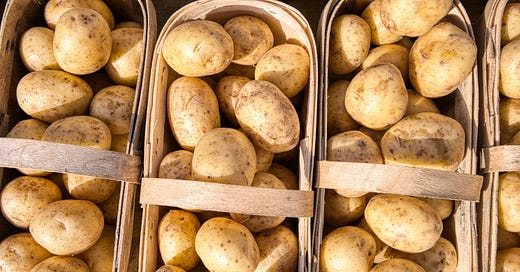



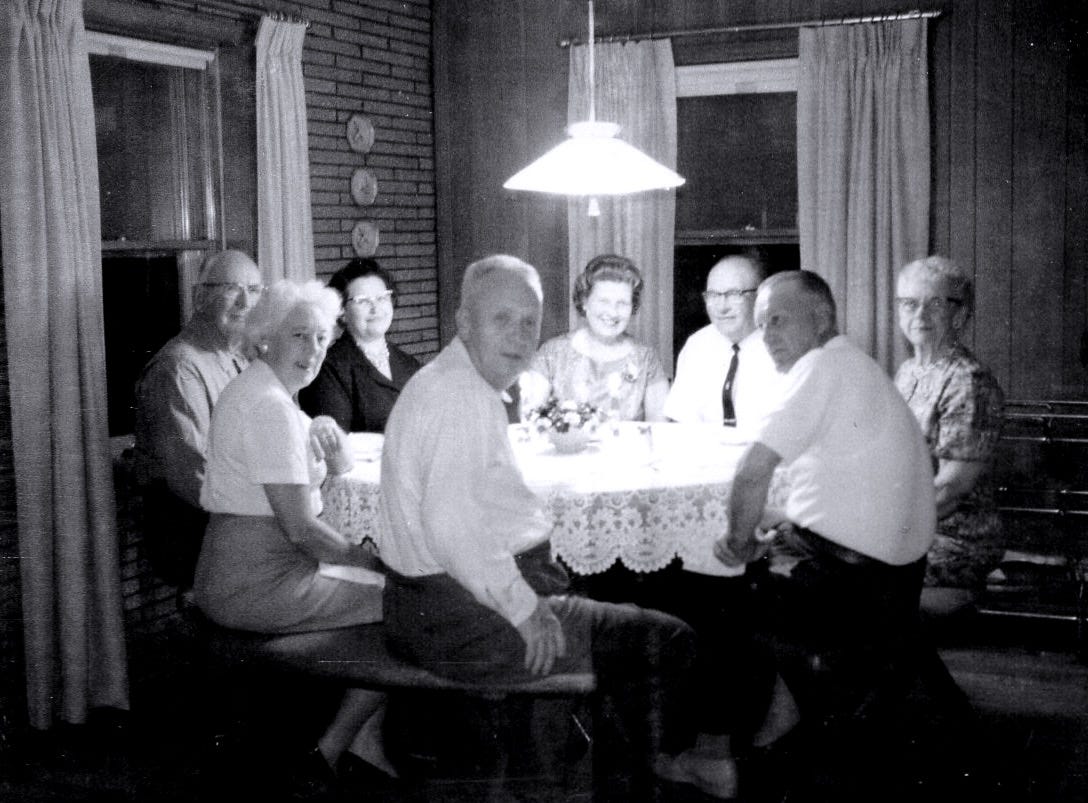
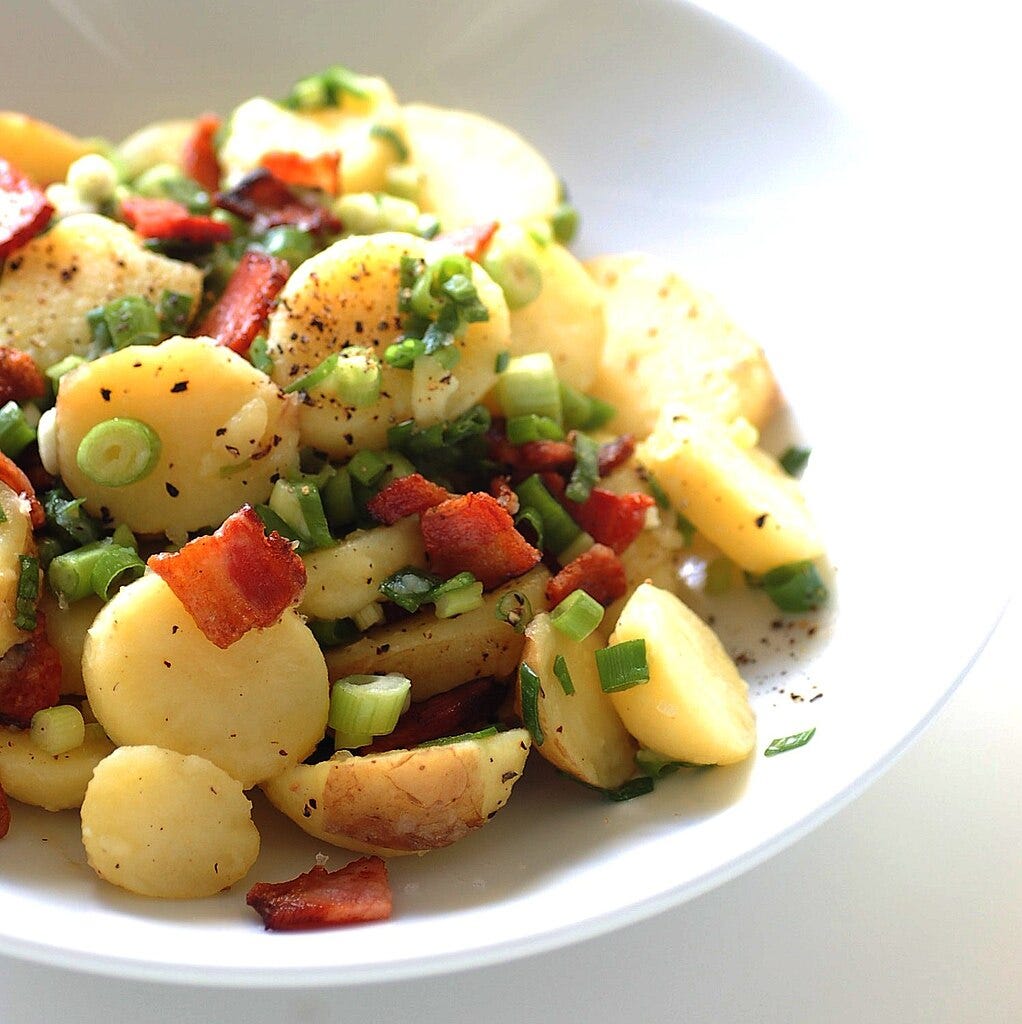
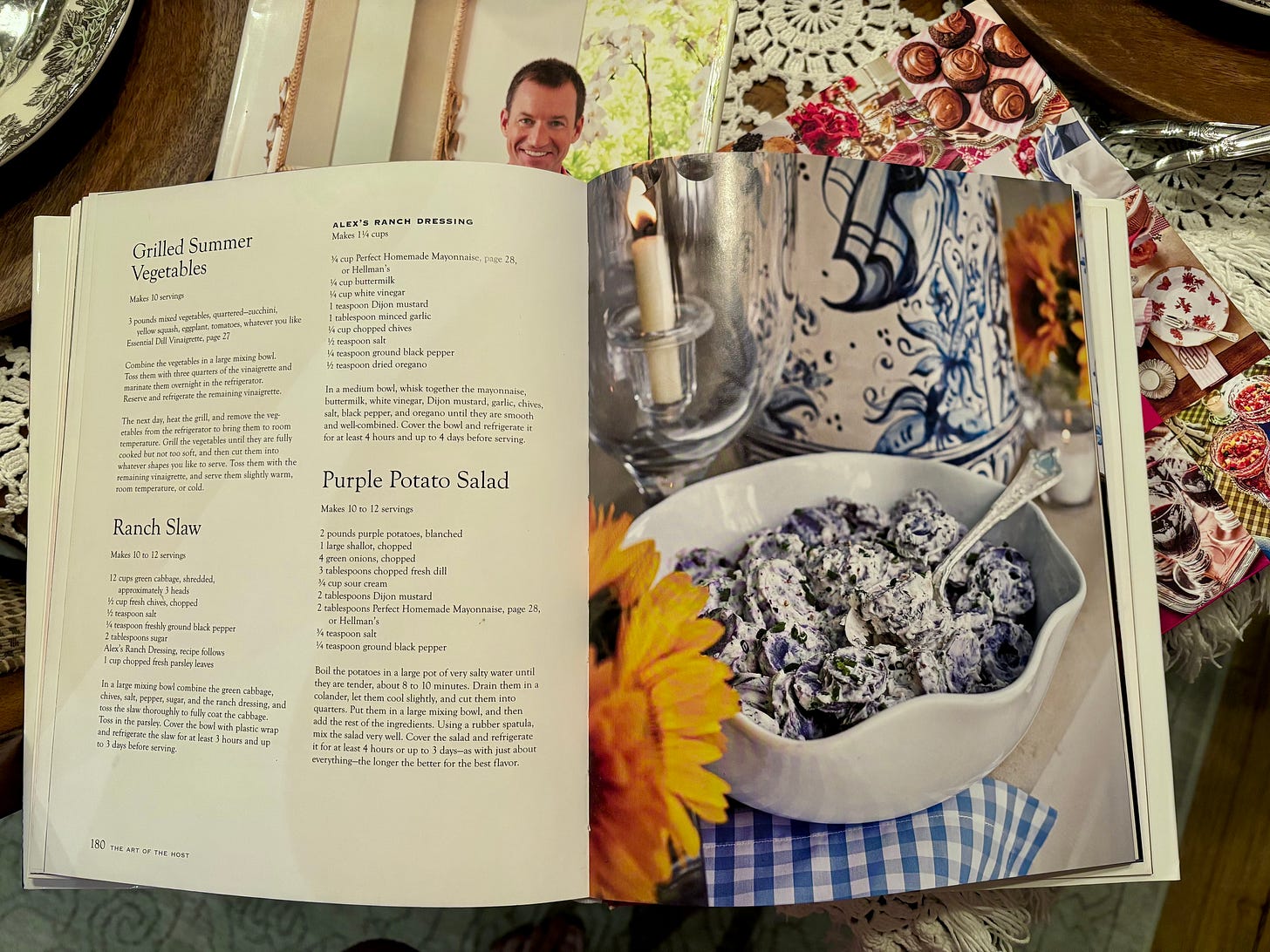
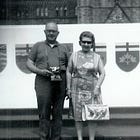



I love reading your posts about the relationship between food and family but it is not something I easily relate to. Food was a minor player in my family life growing up ... I do recall hating school dinners and being a very fuzzy eater. Interestingly, my brother is a real Foodie, makes and cooks his own recipes and grows a lot of what he uses in them. He is certainly creating a relationship between food and family and has grandchildren who really appreciate it.
How much do I love your grandma? "Even after my grandparents settled into a long and abundant retirement, Grandma carried with her a no-waste mentality. Nothing got thrown away. The bone from Easter ham went into split pea soup, and stale bread and pieces of the knust were turned into breadcrumbs, and stuffing. I remember Grandma using old cans to bake delicious Boston Brown Bread, and the cuttings from vegetables to make broth."
I am a German potato salad girl. Don't like mayo in my potato salad. This one looks delicious and much simpler than my favorite, which is my go-to when I have vegans come over: Ottolenghi's Pesto Potato Salad (I just leave off the egg and and parm). I also like to add edamame instead of peas.